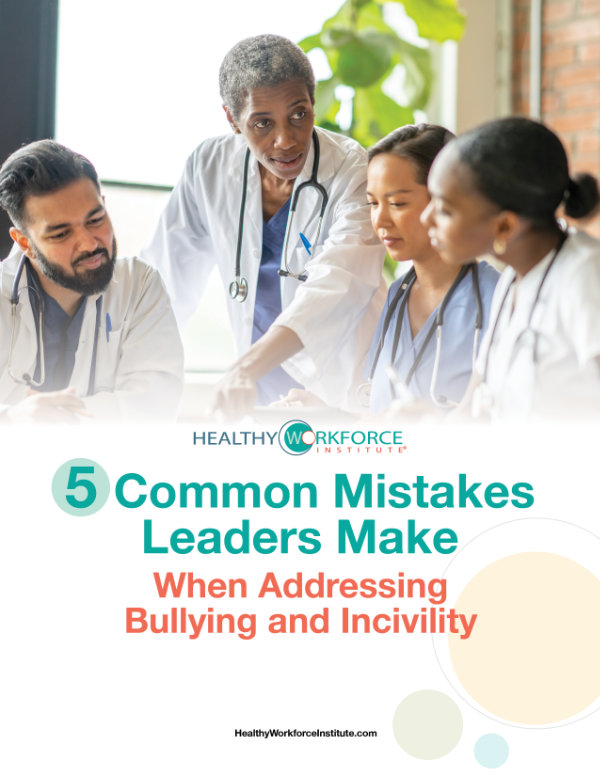 Interprofessional conflict in healthcare is on the rise. Not only does this conflict cause tension between healthcare professionals, but it ultimately impacts patient care. If anyone on the healthcare team isn’t comfortable or willing to communicate with anyone else on the team, it directly impacts a patient. As a healthcare leader, therefore, it is essential to address and mitigate these conflicts to promote a respectful and healthy work culture that ensures safe, quality patient care. In this blog post, we’ll explore three strategies that can help you reduce interprofessional conflict and foster a more collaborative work culture.
Interprofessional conflict in healthcare is on the rise. Not only does this conflict cause tension between healthcare professionals, but it ultimately impacts patient care. If anyone on the healthcare team isn’t comfortable or willing to communicate with anyone else on the team, it directly impacts a patient. As a healthcare leader, therefore, it is essential to address and mitigate these conflicts to promote a respectful and healthy work culture that ensures safe, quality patient care. In this blog post, we’ll explore three strategies that can help you reduce interprofessional conflict and foster a more collaborative work culture.
Why is addressing interprofessional conflict important?
Disruptive behaviors amongst the interprofessional team cultivates a negative culture and impacts the quality and safety of patient care. When disruptive behaviors exist amongst the interprofessional team, it is perceived to compromise patient care by:
- 73% negatively impacts health care
- 53% predictor of adverse events
- 25% contributes to mortality
Ignoring bad behaviors should be a “never event” in healthcare organizations. Team members must feel safe to speak up, and confront disruptive behaviors to prevent medical errors and ensure safe, quality patient care.
How does interprofessional conflict show up in the workplace?
Physicians may treat nurses in a condescending way during patient rounds, belittling or intimidating them in front of others. The reverse happens too when an experienced nurse mocks or tries to intimidate a new medical intern or provider.
Sometimes the interprofessional conflict can be having a difference of opinion about patient care whereas other times, it shows up as rude, disrespectful, and uncivil behavior.
For example:
Bayani is a nurse on a busy medical surgical unit. She had heard from her peers that Dr. Rossi could be condescending to the nurses. Many team members have witnessed him slamming chairs against desks and yelling at nurses in the middle of the unit. One day, Bayani was engaging in interdisciplinary rounds and one of her patients came up for discussion.
Dr. Rossi was leading the discussion and Bayani attempted to contribute additional patient information. Each time Bayani tried to interject; Dr. Rossi ignored her. Finally, Bayani interrupted and began to explain her patient. Almost immediately, Dr. Rossi interrupted Bayani and said, “Excuse me but when you have MD next to your name, then you can speak.”
Nobody said a word and Dr. Rossi continued to discuss the patient.
What can leaders do to reduce interprofessional conflicts in their department?
Leaders spend a tremendous amount of time and energy playing referee to individuals on the healthcare team. Nurses complaining about the physicians, the PCTs complaining about the nurses, and even the physicians stopping by the manager’s office to complain about the nurses.
Just imagine how much “extra” time a leader would have if their teams would just collaboratively work together.
So, what can you do about it?
-
Develop your teams’ assertive communication skills
Assertive communication lies at the core of resolving interprofessional conflicts. Healthcare professionals who communicate using the assertive style are honest and respectful with each other. They tell the truth but do so in a way that preserves the relationship – not destroys it. When people are honest and respectful, they build trust with each other; another key component to a healthy work culture.
Therefore, create opportunities for the interprofessional team to come together, share their insights, and address any concerns in a non-threatening way. One way to achieve this is through regular interprofessional meetings or huddles. By providing a platform for assertive communication, misunderstandings can be avoided, and conflicts can be resolved before they escalate.
-
Learn together
Interprofessional educational programs can significantly contribute to reducing conflicts between nurses and physicians. Move your interprofessional healthcare team to be engaged in joint learning experiences, where they can gain a better understanding of each other’s roles, responsibilities, and expertise. This interprofessional knowledge can help break down stereotypes and misconceptions, fostering empathy and collaboration.
-
- Organize workshops or seminars that focus on interprofessional collaboration, conflict resolution, and teamwork skills. By providing healthcare professionals with the opportunity to learn and work together in a controlled environment, they can develop essential skills to navigate conflicts and build positive working relationships. Let them develop empathy, respect, and appreciation for one another.
- Create simulated opportunities where the interprofessional healthcare team handles complex patient scenarios. It’s like a hands-on crash course to understand each other’s decision-making processes. This type of experience can build bridges showing the team, firsthand, the challenges and pressures their colleagues encounter. By fostering understanding, and practicing communication, you’re lessening the potential for conflicts to arise when the pressure is on in real time.
-
Establish roles and responsibilities
Okay, let’s face it: confusion and overlapping roles can create a perfect storm for interprofessional conflicts. As a healthcare leader, it is crucial to ensure the scope of practice, along with roles and responsibilities are clearly defined and understood by all team members. Leave no room for doubt or misinterpretation. This clarity promotes effective teamwork and prevents misunderstandings that can lead to conflicts.
-
- Create comprehensive job descriptions and protocols, within each disciplines scope of practice, that outlines the specific responsibilities and expectations for members of the healthcare team. Don’t forget to involve all professions in the process! Seek collaborative input to ensure fairness and inclusivity. Regularly review and update these guidelines to accommodate changes in healthcare practices and maintain relevance.
- Implement a structured handoff communication process to ensure patient information is accurately and clearly shared amongst the interprofessional team. Lay out exactly the type of information that needs to be exchanged and establish a standardized communication protocol. By doing so, you’re ensuring critical patient details don’t slip through the cracks, minimizing miscommunication and conflicts that might arise from incomplete or inaccurate handoffs.
Reducing interprofessional conflict is vital for healthcare leaders to foster a positive work culture and enhance patient outcomes. By promoting effective communication, fostering interprofessional education, and establishing clearly defined roles and responsibilities based on scope of practice the interprofessional team can work together harmoniously and resolve conflicts in a constructive manner. Remember, addressing conflicts proactively and promoting a culture of interprofessional collaboration is essential for the well-being of healthcare professionals, the patients they serve, and the healthcare organization.












